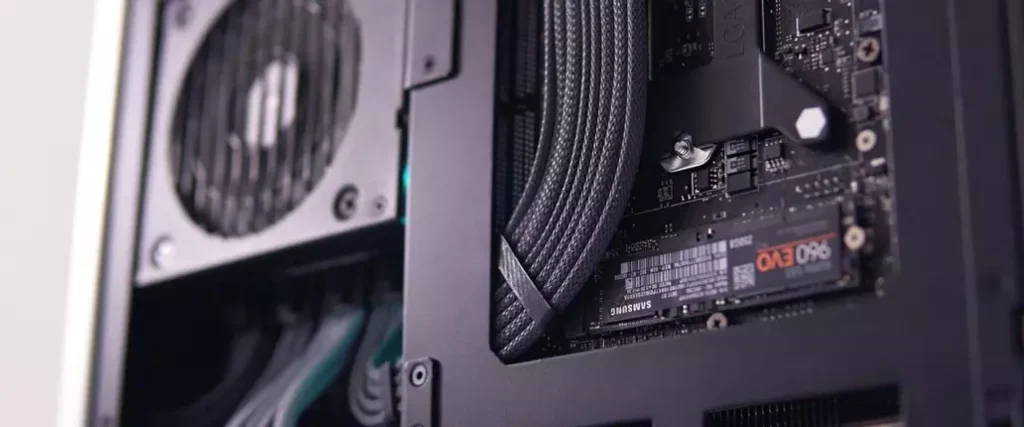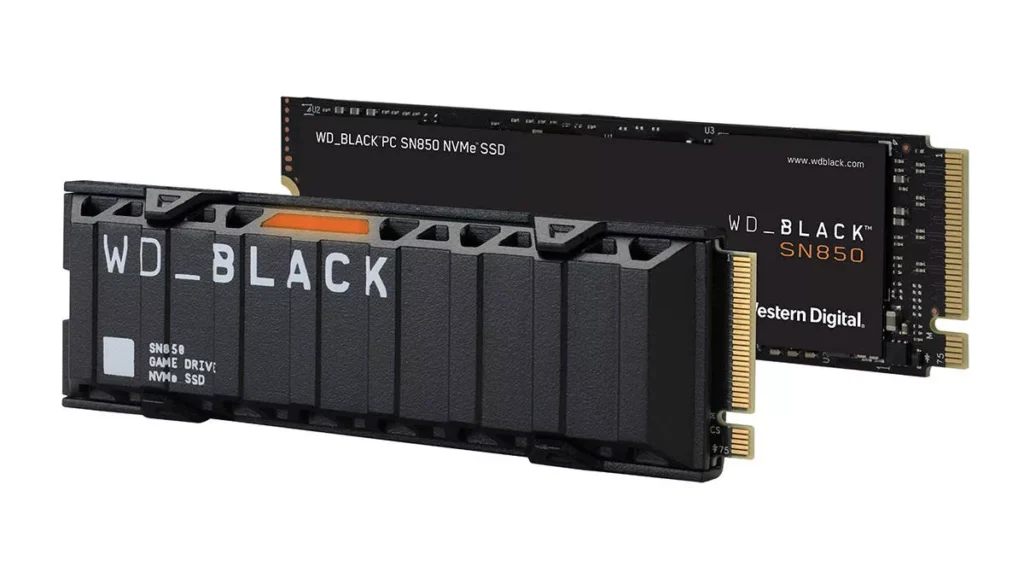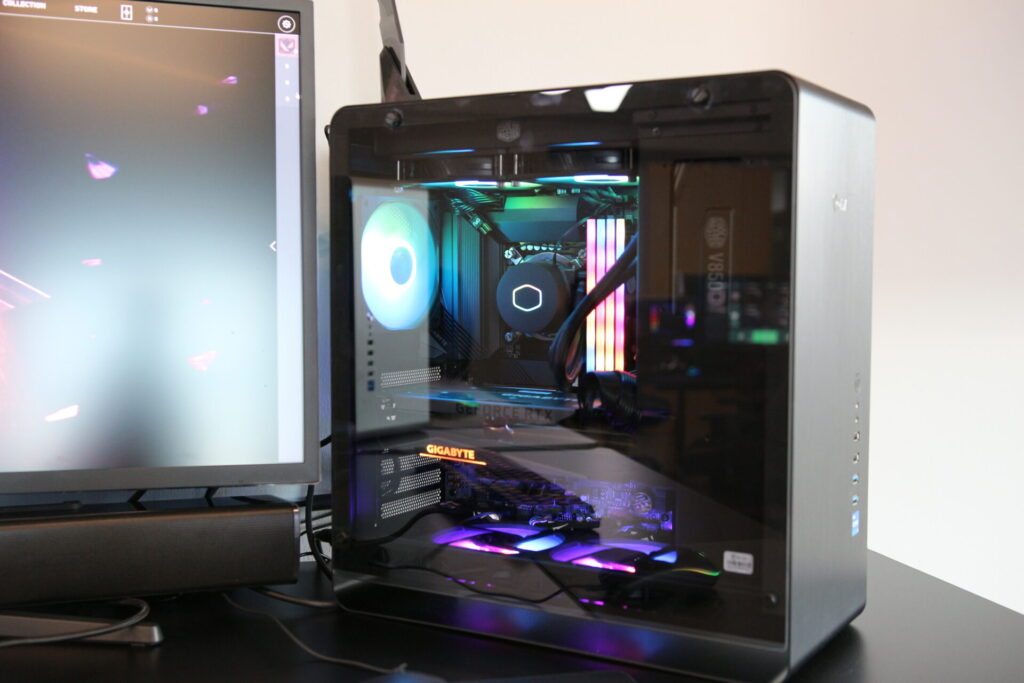Efficient storage is crucial for gaming PC and laptop. It ensures faster game load times, smoother gameplay, and quicker in-game asset loading. Consequently, storage enhances the overall gaming experience.
There are two primary SSD options for gaming PC: NVMe and SATA. In this article, we will explore their unique features and benefits. Additionally, we will help you decide which one best suits your gaming setup.
1. Understanding SSD Technologies
Solid State Drives (SSDs) store data on NAND flash memory chips. Unlike Hard Disk Drives (HDDs), they have no moving parts. Therefore, SSDs can access data quickly and reliably.
SSDs offer several advantages over HDDs for gaming PCs. First, they deliver faster load times, allowing games to start more quickly. Second, they enable seamless gameplay by reducing in-game asset loading times. Finally, SSDs are more durable and consume less power, making them ideal for gaming laptops.
a) NVMe SSDs
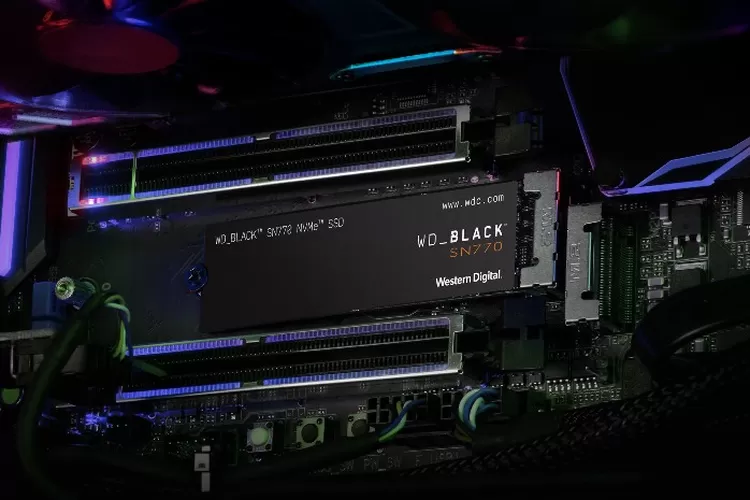
What is NVMe?
NVMe, or Non-Volatile Memory Express, is a storage protocol. It optimizes data transfer between SSDs and the computer’s CPU. NVMe SSDs connect directly to the motherboard via PCIe (Peripheral Component Interconnect Express) slots, ensuring faster data transfer. In essences, its PCIE protocol but used for storage.
Benefits of NVMe SSDs
NVMe SSDs provide various benefits for gaming PCs. Firstly, they deliver significantly higher read and write speeds compared to SATA SSDs. Moreover, NVMe SSDs can handle multiple data requests simultaneously, reducing latency. Ultimately, NVMe SSDs offer top-notch performance, making them a popular choice for high-end gaming laptops and PCs.
b) SATA SSDs
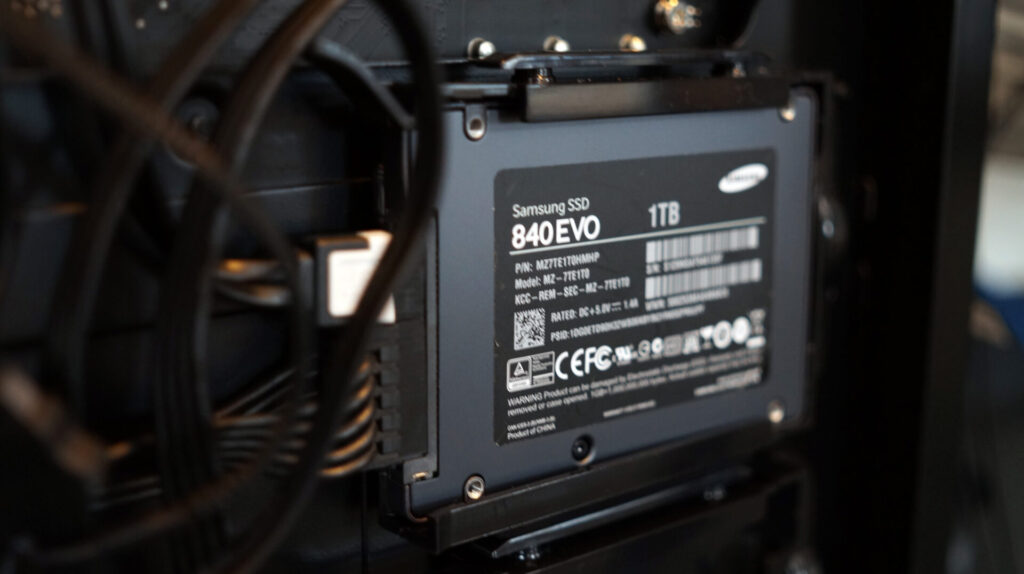
What is SATA?
SATA, or Serial ATA, is a data transfer protocol used in SSDs and HDDs. SATA SSDs connect to the motherboard via SATA cables and utilize the AHCI (Advanced Host Controller Interface) protocol. This protocol is slower than NVMe, but it’s compatible with a wider range of devices.
Benefits of SATA
SATA SSDs offer several advantages for gaming PCs. First, they are more affordable than NVMe SSDs, making them a cost-effective option. Second, SATA SSDs still outperform traditional HDDs, providing improved game load times and asset loading. Lastly, their widespread compatibility ensures they can be easily integrated into most gaming laptops and PCs.
2. Performance Comparison: NVMe vs. SATA SSDs in Gaming PC
a) Speed
Sequential read/write speeds
NVMe SSDs boast impressive sequential read/write speeds, often exceeding 3,500 MB/s and 3,000 MB/s, respectively. For instance, the Samsung 970 EVO Plus reaches read speeds up to 3,500 MB/s and write speeds up to 3,300 MB/s. In contrast, SATA SSDs like the Samsung 860 EVO offer read/write speeds around 550 MB/s and 520 MB/s. Consequently, NVMe SSDs are significantly faster for gaming PCs.
Random read/write speeds
Random read/write speeds are also crucial, especially for tasks like game asset loading. NVMe SSDs generally outperform SATA SSDs in this area. For example, the Samsung 970 EVO Plus boasts random read/write speeds up to 620,000/560,000 IOPS, while the Samsung 860 EVO offers 98,000/90,000 IOPS. Thus, NVMe SSDs provide quicker access to game data, enhancing the gaming experience.
b) Latency
NVMe SSDs have lower latency compared to SATA SSDs due to their direct connection to the motherboard via PCIe. Lower latency translates to faster data access, which benefits gaming performance. As a result, NVMe SSDs are the better choice for reducing latency in gaming laptops and PCs.
c) Game load time
Game load times can significantly impact the gaming experience. NVMe SSDs, with their superior read/write speeds and lower latency, typically reduce game load times compared to SATA SSDs. For example, an NVMe SSD like the Samsung 970 EVO Plus can decrease game load times by up to 30% compared to a SATA SSD like the Samsung 860 EVO.
d) Real-world gaming performance
While NVMe SSDs offer significant advantages in speed and latency, real-world gaming performance differences can be minimal. Most modern gaming laptops and PCs will see noticeable improvements in game load times and asset loading with either type of SSD. However, for users seeking the best possible performance or running particularly demanding games, an NVMe SSD will deliver the ultimate experience.
3. Other Factors to Consider
a) Storage capacity
When selecting an SSD for your gaming PC or laptop, consider the storage capacity. Both NVMe and SATA SSDs are available in various capacities, typically ranging from 256GB to 2TB. Larger capacities provide more space for games, but they also come at a higher price. Balance your storage needs with your budget to make the best choice.
Modern games can require significant storage space, making capacity an essential factor for gaming laptops and PCs. For example, titles like “Call of Duty: Warzone” and “Red Dead Redemption 2” demand over 100GB of storage each. As game worlds become more expansive and detailed, this trend is likely to continue.
To accommodate multiple games and updates, consider opting for a 1TB or 2TB SSD. This increased capacity will allow you to store numerous games without constantly uninstalling and reinstalling them. Ultimately, investing in a larger SSD can save you time and enhance your gaming experience on your gaming laptop or PC.
b) Compatibility with gaming PC components
Before purchasing an SSD, verify its compatibility with your gaming system. For NVMe SSDs, ensure your motherboard has an available PCIe slot and supports the NVMe protocol. Most modern gaming laptops and PCs meet these requirements. SATA SSDs usually have broader compatibility, working with most systems that support SATA connections. Always check your system’s specifications to avoid compatibility issues.
To check compatibility, start by reviewing your gaming laptop or PC’s documentation, which should list the supported SSD interfaces. Additionally, you can search online for your system’s make and model, followed by “SSD compatibility” to find relevant information.
Another approach is to consult your motherboard’s user manual or visit the manufacturer’s website for detailed specifications. Look for the available PCIe or SATA ports and check for NVMe support if considering an NVMe SSD. Taking these steps will help ensure a seamless upgrade for your gaming PC or laptop, maximizing performance and satisfaction.
If you’re new to custom gaming PCs, try using VOLTA PC’s custom PC builder, which not only simplifies the selection process but also notifies you if the chosen parts aren’t compatible with each other.
c) Price and value for money
Price is an important factor when choosing between NVMe and SATA SSDs. NVMe SSDs typically cost more per gigabyte than SATA SSDs. For example, a 1TB Samsung 970 EVO Plus NVMe SSD costs around $150, while a 1TB Samsung 860 EVO SATA SSD is priced at approximately $110. Assess your budget and performance needs to determine the best value for your gaming laptop or PC.
For the most updated SSD prices, check out VOLTA PC’s extensive SSDs selection.
d) Power consumption and heat generation
SSDs consume less power and generate less heat than traditional HDDs. However, there are differences between NVMe and SATA SSDs. NVMe SSDs generally consume more power under load than SATA SSDs due to their higher performance. This factor is especially important for gaming laptops, where battery life and heat management are critical. In such cases, a power-efficient SATA SSD might be a more suitable choice. However, for gaming PCs, where power and heat are less of a concern, the higher performance of NVMe SSDs can be worth the trade-off.
4. Top Picks: Best NVMe and SATA SSDs for Gaming PC
a) Best high-performance NVMe SSDs
Samsung 990 PRO and 980 PRO: These NVMe SSD offers top-tier performance with read/write speeds up to 6900 MB/s and 6800 MB/s. Their RANDOM IOPS is in the millions counts, ensuring that your gaming PC or gaming laptop is lag free. Additionally, it features a 5-year warranty, making it a reliable choice for gaming PCs and laptops.
-
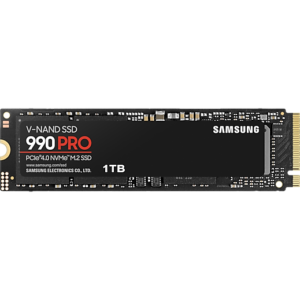 Samsung 990 PRO NVMe PCIe Gen.4 1TB$226.00 w/GST
Samsung 990 PRO NVMe PCIe Gen.4 1TB$226.00 w/GST -
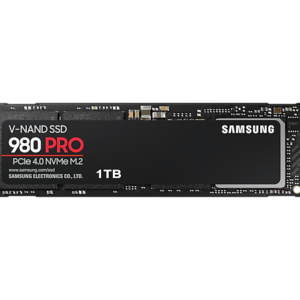 Samsung 980 PRO NVMe PCIe Gen.4 1TB$178.00 w/GST
Samsung 980 PRO NVMe PCIe Gen.4 1TB$178.00 w/GST
Western Digital Black SN850: Another high-performance option, the SN850 boasts read speeds up to 7,000 MB/s and write speeds up to 5,300 MB/s. Its 3D NAND technology ensures durability and efficiency, ideal for gaming systems.
b) Best budget-friendly NVMe SSDs
Crucial P5: This affordable NVMe SSD delivers solid performance with read/write speeds up to 3,400 MB/s and 3,000 MB/s. Its 5-year warranty and competitive price make it an excellent choice for budget-conscious gamers.
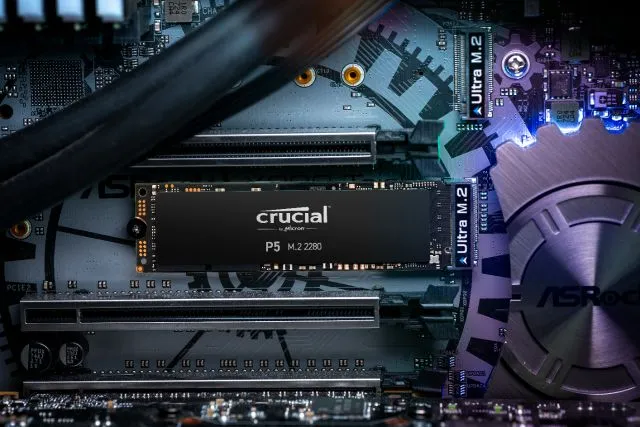
Kingston A2000: The A2000 offers good performance at a lower price, with read/write speeds up to 2,200 MB/s and 2,000 MB/s. This SSD is perfect for gamers seeking a balance between price and performance.
c) Best high-performance SATA SSDs
Samsung 860 EVO: This popular SATA SSD offers impressive performance with read/write speeds up to 550 MB/s and 520 MB/s. It also features a 5-year warranty, ensuring reliability for gaming laptops and PCs.
SanDisk Ultra 3D: The Ultra 3D provides great read/write speeds up to 560 MB/s and 530 MB/s. Its nCache 2.0 technology enhances performance, making it suitable for gaming systems.
d) Best budget-friendly SATA SSDs
Crucial MX500: This cost-effective SATA SSD offers good performance with read/write speeds up to 560 MB/s and 510 MB/s. Its 5-year warranty and competitive price make it an attractive option for budget gamers.
Kingston A400: The A400 is a budget-friendly SATA SSD with read/write speeds up to 500 MB/s and 450 MB/s. It’s an excellent choice for gamers looking to upgrade their storage without breaking the bank.
Conclusion: NVMe SSD is the ideal choice for gaming PC
Deciding between NVMe and SATA SSDs for gaming ultimately depends on your priorities. If you’re seeking top-notch performance and faster load times, an NVMe SSD is the ideal choice. However, if you’re on a budget and still want improved performance compared to HDDs, a SATA SSD is a viable option.
Optimizing gaming PC storage is crucial for enhancing your gaming experience. Carefully consider factors such as speed, capacity, compatibility, and price when selecting the perfect SSD for your gaming laptop or PC.
Looking to upgrade or customize your gaming experience? Check out VOLTA PC for a wide range of gaming laptops and custom-built gaming PCs that cater to your unique needs.
